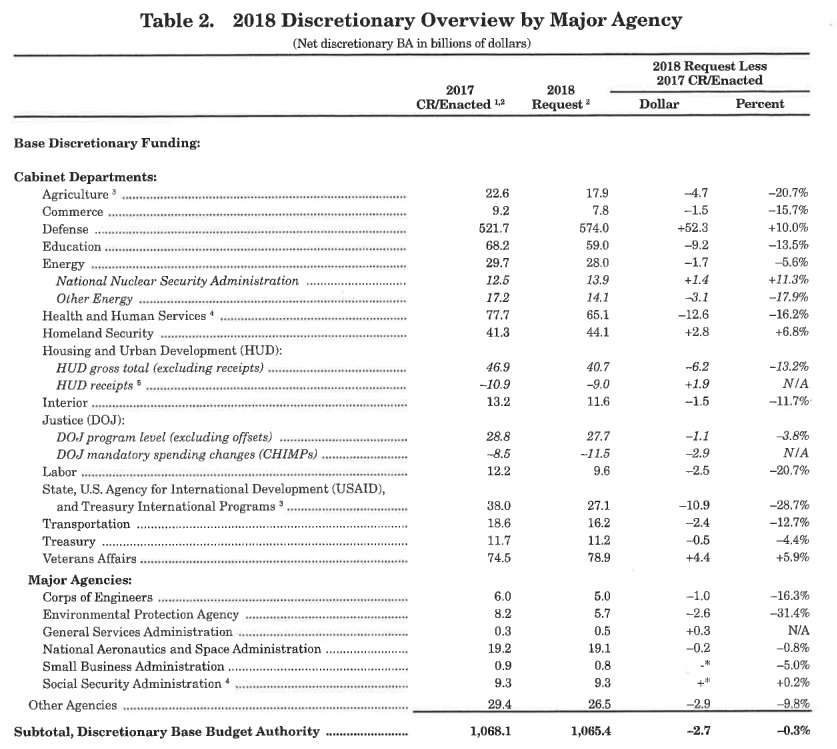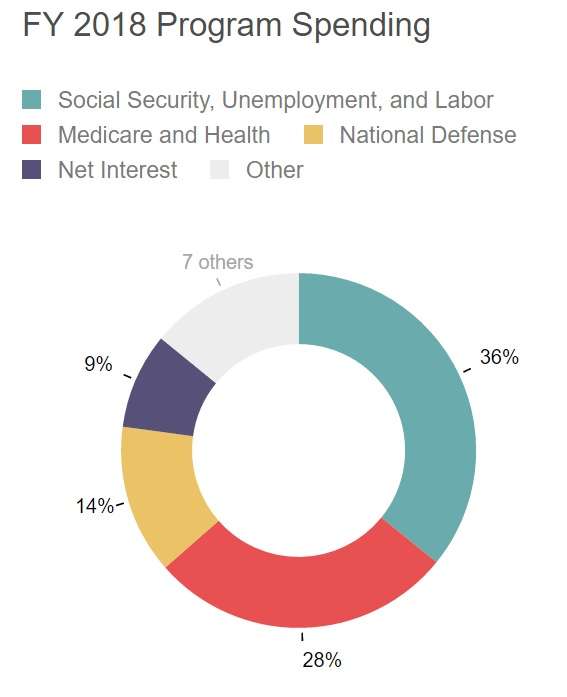Why Trump's Budget Blueprint Loses Libertarians
Defense and Homeland Security hikes make up for cuts in discretionary spending. Does the government always need to spend $4 trillion?

President Donald Trump has released what was being touted as a "skinny" budget, meaning that it would put federal spending on a diet. Would that that were true. The blueprint, which doesn't engage with entitlements such as Medicare and Social Security and other forms of "mandatory" spending at all, simply balances cuts to various parts of the government with increases to the Departments of Defense and Homeland Security. In fiscal 2017, the government plans to spend around $1.1 trillion in discretionary spending (this is spending that is voted on every year; the rest of the federal budget is essentially on autopilot). Under Trump's plan, it will spend that much again in 2018. Overall federal spending will still come in around $4 trillion.
Let's call this what it is: Unacceptable.
Federal spending remains at historically high levels both in absolute terms and as a percentage of GDP. Since 2008, outlays have been higher than 20 percent of GDP, well above the post-war average and most of the 1990s. While revenues have soared to record levels in absolute dollars, they come nowhere close to matching outlays, the result being continuing deficits and growing national debt, which is already greater than annual GDP. Because of the automatic spending increases built into "mandatory" programs such as Medicare and Social Security, the Congressional Budget Office (CBO) projects growing debt over the next decade. Given the well-established correlation between persistent, high levels of national debt and reduced economic growth—"debt overhangs"—this is not simply bad news but ruinous. Left-wing economists affiliated with the University of Massachusetts found "the average real GDP growth rate for countries carrying a public-debt-to-GDP ratio of over 90 percent is…2.2 percent." That's the same sluggish growth found by more market-friendly economists Carmen Reinhart, Kenneth Rogoff, and Vincent Reinhart: "On average, debt levels above 90 percent

are associated with growth that is 1.2 percent lower than in other periods (2.3 percent versus 3.5 percent)." Indeed, in 20 out of 26 debt-overhang cases studied by Reinhart, Rogoff, and Reinhart, the period of reduced growth lasted a quarter-century, substantially reducing GDP and living standards (see chart to right).
As it stands, CBO is already projecting historically low rates of economic growth over the coming decade. Earlier this year, CBO said it expects the economy to grow by just 1.8 percent annually through 2027, well behind post-war rates of 3 percent or higher. And that already meager growth comes after eight years of just 1.4 percent on average per year. In a conversation with Matt Welch and me at the 2016 International Students for Liberty Conference, George Will observed that the difference between 2 percent annual growth and 3 percent annual growth is the difference between a positive, forward-looking country in which politics recede from everyday life and a Hobbesian nightmare in which interest groups slug it out over a barely growing pie. Note that he was talking about 2 percent annual growth, which seems positively aspirational in the 21st century.
That's not to say that Trump's budget blueprint, which he has already signaled is merely the start of negotiations with Congress, doesn't have some positives. Indeed, it's bracing and good to see a plan that takes a hacksaw if not a chainsaw to various federal departments (even as I suspect most cuts will be bargained away in order to secure the hikes he wants). Here's Table 2 of his plan, which summarizes how departments and agencies would be affected:

In percentage terms, there are double-digit cuts to cabinet departments such as Agriculture, Commerce, Education, Interior, and Transportation. The EPA takes it on the chin, facing a 31.4 percent budget cut. The howls of indignation from supporters of the status quo are already sounding around the internet and cable news programs, but there's every reason to believe that such savings can be accomplished with little to no impact on public safety or essential government functions. Another way of saying this is that government is a lagging indicator in American society and just as every business, household, and individual has spent the last decade-plus becoming more efficient, productive, and economical, now it's the feds' turn.
The fact of the matter is that while discretionary government spending has been relatively flat over the past several years, there were major, across-the-board increases pushed through during the Bush years and the early Obama years. As Mercatus Center economist and Reason columnist Veronique de Rugy has documented, spending ballooned by 53 percent in real terms under George W. Bush and has never gone down to anything like pre-9/11 totals. And we need to underscore that, on balance, Trump spends exactly as much as last year's discretionary budget. This is where he loses any credibility with libertarians. There is no reason to think that the Departments of Defense and Homeland Security could not function with the same sort of double-digit cuts the president levies on other departments and agencies. If Trump were truly a foe of the administrative state in any sort of principled way, I'd expect him to be abolishing Homeland Security, a widely criticized agglomeration of power that has few supporters outside of those drawing food from its trough. "The President's 2018 budget ends the arbitrary depletion of our strength and security, and begins to rebuild the U.S. Armed Forces," reads the blueprint. It's good, I suppose, that the White House recognizes that all the wars of the past 15 years were in some way "arbitrary," but the way to stop depleting our military is to stop sending it all over the globe in fruitless endeavors that have turned Libya, Syria, Iraq, Afghanistan, and other places into danger zones. In the same breath, Trump's document brags that the $52 billion increase he seeks above current levels of defense spending "exceeds the entire defense budgets of most countries." Do we really need it then? Worse still: De Rugy and Harvard economist Robert Barro found that "a dollar increase in federal defense spending results in a less-than-a-dollar increase in GDP when the spending increase is deficit financed." If government spending is rarely stimulative under the best of circumstances, the sort of defense hike Trump is pushing actually shrinks an already wizened economy.

To this point, we've only been talking about discretionary spending, which accounts for only about one-third of the federal budget. The rest covers mandatory spending on Medicare, Social Security, and other entitlements along with interest on the debt. If Willie Sutton robbed banks because that's where the money was, any plan to seriously reduce government spending and debt service and thus hack away at the administrative state must confront entitlements. Trump has been unambiguous in saying that he doesn't want to touch Social Security or Medicare/Medicaid, which are already the two biggest-ticket items in the federal budget and will only grow over the coming years due to the aging of the baby boom generation.
To date, all of the baby boom presidents—Bill Clinton, George W. Bush, Barack Obama—punted on serious entitlement reform, stoking instead generational warfare between relatively young and poor Millennials and relatively old and wealthy boomers. Trump, who may well be the last boomer president (here's hoping), shows every indication of putting his cohort's interests before those of his children and grandchildren. Although basic budgetary realities will sink old-age entitlements sometime around 2030 and inflict 25 percent or more cuts in benefits, the Democrats and Republicans writ large have refused to seriously address the iceberg on the horizon.
Many of Donald Trump's supporters evinced an interest in "burning it down," in razing Washington figuratively as the British did during the War of 1812. In his first budget blueprint, their champion has not only failed to do that, he hasn't even really thrown a good first punch. Despite offering significant reductions to parts of the federal budget, he hasn't even submitted a plan that would reduce overall outlays after a decades-long spending spree that has purchased little but debt, deficits, and economic malaise.
